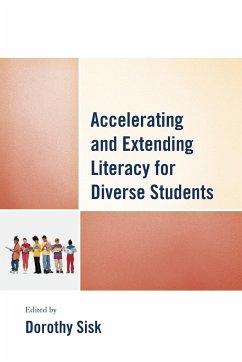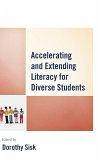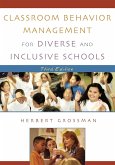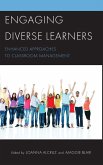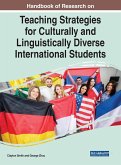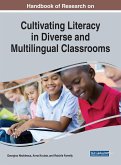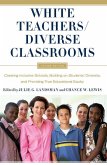Accelerating and Extending Literacy for Diverse Students
Herausgeber: Sisk, Dorothy
Accelerating and Extending Literacy for Diverse Students
Herausgeber: Sisk, Dorothy
- Broschiertes Buch
- Merkliste
- Auf die Merkliste
- Bewerten Bewerten
- Teilen
- Produkt teilen
- Produkterinnerung
- Produkterinnerung
Accelerating and Extending Literacy for Diverse Students addresses the need to equip teachers with the best research and practices to ensure they become dedicated to not just teaching, but knowing and reaching diverse learners.
Andere Kunden interessierten sich auch für
![Accelerating and Extending Literacy for Diverse Students Accelerating and Extending Literacy for Diverse Students]() Accelerating and Extending Literacy for Diverse Students142,99 €
Accelerating and Extending Literacy for Diverse Students142,99 €![Engaging Diverse Learners Engaging Diverse Learners]() Engaging Diverse Learners48,99 €
Engaging Diverse Learners48,99 €![Classroom Behavior Management for Diverse and Inclusive Schools Classroom Behavior Management for Diverse and Inclusive Schools]() Herbert GrossmanClassroom Behavior Management for Diverse and Inclusive Schools110,99 €
Herbert GrossmanClassroom Behavior Management for Diverse and Inclusive Schools110,99 €![Engaging Diverse Learners Engaging Diverse Learners]() Engaging Diverse Learners111,99 €
Engaging Diverse Learners111,99 €![Handbook of Research on Teaching Strategies for Culturally and Linguistically Diverse International Students Handbook of Research on Teaching Strategies for Culturally and Linguistically Diverse International Students]() Handbook of Research on Teaching Strategies for Culturally and Linguistically Diverse International Students290,99 €
Handbook of Research on Teaching Strategies for Culturally and Linguistically Diverse International Students290,99 €![Handbook of Research on Cultivating Literacy in Diverse and Multilingual Classrooms Handbook of Research on Cultivating Literacy in Diverse and Multilingual Classrooms]() Handbook of Research on Cultivating Literacy in Diverse and Multilingual Classrooms309,99 €
Handbook of Research on Cultivating Literacy in Diverse and Multilingual Classrooms309,99 €![White Teachers / Diverse Classrooms White Teachers / Diverse Classrooms]() White Teachers / Diverse Classrooms53,99 €
White Teachers / Diverse Classrooms53,99 €-
-
-
Accelerating and Extending Literacy for Diverse Students addresses the need to equip teachers with the best research and practices to ensure they become dedicated to not just teaching, but knowing and reaching diverse learners.
Hinweis: Dieser Artikel kann nur an eine deutsche Lieferadresse ausgeliefert werden.
Hinweis: Dieser Artikel kann nur an eine deutsche Lieferadresse ausgeliefert werden.
Produktdetails
- Produktdetails
- Verlag: Rowman & Littlefield Publishers
- Seitenzahl: 234
- Erscheinungstermin: 13. August 2015
- Englisch
- Abmessung: 229mm x 152mm x 14mm
- Gewicht: 387g
- ISBN-13: 9781475817850
- ISBN-10: 1475817851
- Artikelnr.: 42558996
- Herstellerkennzeichnung
- Libri GmbH
- Europaallee 1
- 36244 Bad Hersfeld
- gpsr@libri.de
- Verlag: Rowman & Littlefield Publishers
- Seitenzahl: 234
- Erscheinungstermin: 13. August 2015
- Englisch
- Abmessung: 229mm x 152mm x 14mm
- Gewicht: 387g
- ISBN-13: 9781475817850
- ISBN-10: 1475817851
- Artikelnr.: 42558996
- Herstellerkennzeichnung
- Libri GmbH
- Europaallee 1
- 36244 Bad Hersfeld
- gpsr@libri.de
Edited by Dorothy Sisk
Foreword Preface Introduction Chapter 1- Using Culturally Responsive
Teaching to Differentiate and Accelerate Literacy for Diverse Learners
Dorothy A. Sisk What it means to be culturally sensitive teacher Importance
of the Teacher as the Primary Agent of Change Culturally Relevant Pedagogy
Culturally Responsive Teaching is Validating Culturally Responsive Teaching
is Comprehensive Culturally Responsive Teaching is Multidimensional
Culturally Responsive Teaching is Empowering Culturally Responsive Teaching
is Transformative Culturally Responsive Teaching is Emancipatory The
Challenge of Culturally Responsive Teaching with Students of Poverty
Conclusion References Teacher Voice Read On Log On Reflect On Chapter 2-
DISCOVER: A Model for Identifying and Nurturing Strengths in Creative
Problem C. June Maker Solving across Diverse Domains of Ability Problem
Solving: The Key Construct in Intelligence and Creativity Designing
Challenging Questions and Problems: The DISCOVER Problem Continuum The
Closed Problems The Semi-Open Problems The Open-Ended Problems
Performance-Based Assessments of Creative Problem Solving in Human
Abilities Hands-On Activities Hands-On Assessment Activities for Preschool
Children Oral Linguistic Math Spatial Hands-On Assessment Activities for
Elementary and Middle School Students Spatial Artistic Spatial Analytical
Oral Linguistic Hands-On Assessment Activities for High School Students and
Adults Spatial Analytical Spatial Artistic Oral Linguistic Naturalist
Mechanical-Technical Personal Paper/Pencil Activities Paper and Pencil
Assessment Activities for Elementary and Middle School Students Concept
Maps Math Written Linguistic Paper and Pencil Assessment Activities for
High School Students and Adults Concept Maps Math Written Linguistic Talent
and Ability Profiles Nurturing the Talents and Strengths of Students: The
DISCOVER Curriculum Model Research on the DISCOVER Model Assessment
Research on Diverse Students Conclusion References Teacher Voice Read On
Log On Reflect On Chapter 3- Motivating Gifted Readers Sandra Kaplan and
Jessica Manzone Another Focus on Motivation Strategies to Increase Student
Motivation Strategy#1 - Student-to-Student Book Messaging Strategy#2 - Time
and Place Reading Decisions: Strategy#3 - Recognition of Difference in How
to Read: Strategy#4 - Reading Alignment to the Nature of Giftedness:
Strategy#5 - Reading Like a Disciplinarian: Connections to the Common Core
State Standards Conclusion References Teacher Voice Read On Log On Reflect
On Chapter 4- Happy Teachers Will Change the World: Nurturing the Inner
Life of Teachers Michele Kane Revisiting Research Reconsider and Reflect on
Personal Challenges Positive Qualities Red Flags of Ineffective Teaching
Renewing Passion and Purpose for your Profession Recognizing the Elements
of Well-Being Rekindling Beginner's Mind and Remaining Present Reclaiming
Positivity and Well-Being School Response: Teaching and Learning Increased
School's Gross National Happiness Conclusion References Teacher Voice Read
On Log On Reflect On Chapter 5- Engaging and Effective Strategies for
English Language Learners Elsa Fernandez Anderson Developing Critical
Thinking Developing Academic Vocabulary Developing Literacy Case Study
Sample of Strategies Incorporating CLD Pedagogy Strategy: SWIRL Strategies
to move from social to academic language Strategy: Is it a Fact? -Social
Language Version Strategy: Is it a Fact? -Academic Language Version
Strategy: Visual Discoveries -Social Language Version Strategy: Visual
Discoveries -Academic Language Version Strategy: What's the Symbol? -
Variation Strategy Strategy: Words In, Words Out Strategy: Question Ladders
Conclusion References Teacher Voice Read On Log On Reflect On Chapter 6-
The Use of Response to Intervention (RtI) to Provide Instruction for
Twice-Exceptional Students Debra A. Troxclair Diversity-Conformity Paradox
Response to Intervention: Initial Focus on Assessment on Learning
Disabilities Response to Intervention: Gifted Learners Twice-Exceptional
Gifted Learners Status of Response to Intervention (RtI) and Gifted
Learners Response to Intervention (RtI) and Literacy Instruction for
Twice-Exceptional Learners Response to Intervention Framework:
Identification of Twice-Exceptional GT/LD Students Response vs.
Non-Response Element of (RtI) Screening for GT/LD Conclusion References
Teacher Voice Read On Log On Reflect On Chapter 7- Learning, Reading, and
Writing Words Closely and Deeply: The Archaeology of Thought Shane
Templeton Activities The First Layer: Latin and Greek Roots and Affixes
Exploring the Layer: Etymology and the Dictionary More Advanced Etymology:
The Assimilation of Prefixes Serious Archaeology: Indo-European Roots
Application to Learning a New Language Conclusion References Teacher Voice
Read On Log On Reflect On Chapter 8- Academic Language Across the Genre
Eugenia Mora-Flores and Sandra Kaplan Reading Around the Genre Academic
Language Academic Language Role of Academic Language Connection of Academic
Language to Standards Differentiating Academic Language Scaffolding
Collaboration Conclusion References Teacher Voice Read On Log On Reflect On
Chapter 9- Using Technology to Accelerate Literacy for Diverse Learners L.
Kay Abernathy A Literacy Teacher in the Digital Age History of the Digital
Age Empowering and Emancipatory Effects of Technology Technology and Global
Perspective Technology, Social Software, and Second Language Learners
Technology and Responsive Pedagogy Technology, Transformation, and
Validation Assistive Technology and Physical Disabilities Technology and
Digital Stories Conclusion References Teacher Voice Read On Log On Reflect
On Chapter 10- Picture Book Essentials and the English Language Arts Common
Core Standards Laura Beltchenko A Lens on ELA CCSS and Implications for
English Language Learners (ELLs) Theory into Practice A Lens on ELA CCSS,
Text Complexity and Text Leveling The Value of Reading Aloud A Lens on ELA
CCSS, Read Alouds, Vocabulary Development, Speaking and Listening
Multicultural Literature Perspective in Children's Books A Lens on ELA
CCSS, Culture and Diversity Books with Pictures, Picture Books, Picture
Story Books and Illustrated Books Supporting Children's ZPD through Text
and Illustration Interaction Looking through the Lens of Three Learners
Cognitive and Affective Purpose of Viewing the Picture Book Conclusion
References Teacher Voice Read On Log On Reflect On Chapter 11- Using Visual
Literacy and Images as a Gateway to Expand Diverse Students' Critical
Thinking and Literacy Development Donna L. Knoell History of Visuals in the
Communication Process Research and Best Practices Gateway to Learning for
Diverse Students The Power and Impact of Visual Communication Classroom
Instructional Opportunities: Moving Instructional Potential Forward
Practical Suggestions for Implementing Visual Literacy Skills in Diverse
Classrooms Conclusion References Teacher Voice Read On Log On Reflect On
Chapter 12- Using Bibliotherapy to Support the Social and Emotional Needs
of Diverse Students Heather A. Harder Meeting the Social and Emotional
Needs of Diverse Students Bibliotherapy to the Rescue Bibliotherapy Defined
Benefits of Bibliotherapy How Bibliotherapy Works Creating a Bibliotherapy
Plan Criteria for Selecting Books for Bibliotherapy Conclusion References
Recommended picture books to use with culturally and linguistically diverse
students Diversity, Equality & Multicultural Issues Teacher Voice Read On
Log On Reflect On Chapter 13- Crossing the Divide: Storytelling as a Bridge
to Student-Teacher Connection Marc Kuly The Divide A Rationale for Crossing
the Divide Building Bridges: Storytelling in Practice Conclusion References
Teacher Voice Read On Log On Reflect On Chapter 14- Putting it Altogether:
Accelerating and Extending the Literacy of Diverse Students Dorothy Sisk
Conclusion
Teaching to Differentiate and Accelerate Literacy for Diverse Learners
Dorothy A. Sisk What it means to be culturally sensitive teacher Importance
of the Teacher as the Primary Agent of Change Culturally Relevant Pedagogy
Culturally Responsive Teaching is Validating Culturally Responsive Teaching
is Comprehensive Culturally Responsive Teaching is Multidimensional
Culturally Responsive Teaching is Empowering Culturally Responsive Teaching
is Transformative Culturally Responsive Teaching is Emancipatory The
Challenge of Culturally Responsive Teaching with Students of Poverty
Conclusion References Teacher Voice Read On Log On Reflect On Chapter 2-
DISCOVER: A Model for Identifying and Nurturing Strengths in Creative
Problem C. June Maker Solving across Diverse Domains of Ability Problem
Solving: The Key Construct in Intelligence and Creativity Designing
Challenging Questions and Problems: The DISCOVER Problem Continuum The
Closed Problems The Semi-Open Problems The Open-Ended Problems
Performance-Based Assessments of Creative Problem Solving in Human
Abilities Hands-On Activities Hands-On Assessment Activities for Preschool
Children Oral Linguistic Math Spatial Hands-On Assessment Activities for
Elementary and Middle School Students Spatial Artistic Spatial Analytical
Oral Linguistic Hands-On Assessment Activities for High School Students and
Adults Spatial Analytical Spatial Artistic Oral Linguistic Naturalist
Mechanical-Technical Personal Paper/Pencil Activities Paper and Pencil
Assessment Activities for Elementary and Middle School Students Concept
Maps Math Written Linguistic Paper and Pencil Assessment Activities for
High School Students and Adults Concept Maps Math Written Linguistic Talent
and Ability Profiles Nurturing the Talents and Strengths of Students: The
DISCOVER Curriculum Model Research on the DISCOVER Model Assessment
Research on Diverse Students Conclusion References Teacher Voice Read On
Log On Reflect On Chapter 3- Motivating Gifted Readers Sandra Kaplan and
Jessica Manzone Another Focus on Motivation Strategies to Increase Student
Motivation Strategy#1 - Student-to-Student Book Messaging Strategy#2 - Time
and Place Reading Decisions: Strategy#3 - Recognition of Difference in How
to Read: Strategy#4 - Reading Alignment to the Nature of Giftedness:
Strategy#5 - Reading Like a Disciplinarian: Connections to the Common Core
State Standards Conclusion References Teacher Voice Read On Log On Reflect
On Chapter 4- Happy Teachers Will Change the World: Nurturing the Inner
Life of Teachers Michele Kane Revisiting Research Reconsider and Reflect on
Personal Challenges Positive Qualities Red Flags of Ineffective Teaching
Renewing Passion and Purpose for your Profession Recognizing the Elements
of Well-Being Rekindling Beginner's Mind and Remaining Present Reclaiming
Positivity and Well-Being School Response: Teaching and Learning Increased
School's Gross National Happiness Conclusion References Teacher Voice Read
On Log On Reflect On Chapter 5- Engaging and Effective Strategies for
English Language Learners Elsa Fernandez Anderson Developing Critical
Thinking Developing Academic Vocabulary Developing Literacy Case Study
Sample of Strategies Incorporating CLD Pedagogy Strategy: SWIRL Strategies
to move from social to academic language Strategy: Is it a Fact? -Social
Language Version Strategy: Is it a Fact? -Academic Language Version
Strategy: Visual Discoveries -Social Language Version Strategy: Visual
Discoveries -Academic Language Version Strategy: What's the Symbol? -
Variation Strategy Strategy: Words In, Words Out Strategy: Question Ladders
Conclusion References Teacher Voice Read On Log On Reflect On Chapter 6-
The Use of Response to Intervention (RtI) to Provide Instruction for
Twice-Exceptional Students Debra A. Troxclair Diversity-Conformity Paradox
Response to Intervention: Initial Focus on Assessment on Learning
Disabilities Response to Intervention: Gifted Learners Twice-Exceptional
Gifted Learners Status of Response to Intervention (RtI) and Gifted
Learners Response to Intervention (RtI) and Literacy Instruction for
Twice-Exceptional Learners Response to Intervention Framework:
Identification of Twice-Exceptional GT/LD Students Response vs.
Non-Response Element of (RtI) Screening for GT/LD Conclusion References
Teacher Voice Read On Log On Reflect On Chapter 7- Learning, Reading, and
Writing Words Closely and Deeply: The Archaeology of Thought Shane
Templeton Activities The First Layer: Latin and Greek Roots and Affixes
Exploring the Layer: Etymology and the Dictionary More Advanced Etymology:
The Assimilation of Prefixes Serious Archaeology: Indo-European Roots
Application to Learning a New Language Conclusion References Teacher Voice
Read On Log On Reflect On Chapter 8- Academic Language Across the Genre
Eugenia Mora-Flores and Sandra Kaplan Reading Around the Genre Academic
Language Academic Language Role of Academic Language Connection of Academic
Language to Standards Differentiating Academic Language Scaffolding
Collaboration Conclusion References Teacher Voice Read On Log On Reflect On
Chapter 9- Using Technology to Accelerate Literacy for Diverse Learners L.
Kay Abernathy A Literacy Teacher in the Digital Age History of the Digital
Age Empowering and Emancipatory Effects of Technology Technology and Global
Perspective Technology, Social Software, and Second Language Learners
Technology and Responsive Pedagogy Technology, Transformation, and
Validation Assistive Technology and Physical Disabilities Technology and
Digital Stories Conclusion References Teacher Voice Read On Log On Reflect
On Chapter 10- Picture Book Essentials and the English Language Arts Common
Core Standards Laura Beltchenko A Lens on ELA CCSS and Implications for
English Language Learners (ELLs) Theory into Practice A Lens on ELA CCSS,
Text Complexity and Text Leveling The Value of Reading Aloud A Lens on ELA
CCSS, Read Alouds, Vocabulary Development, Speaking and Listening
Multicultural Literature Perspective in Children's Books A Lens on ELA
CCSS, Culture and Diversity Books with Pictures, Picture Books, Picture
Story Books and Illustrated Books Supporting Children's ZPD through Text
and Illustration Interaction Looking through the Lens of Three Learners
Cognitive and Affective Purpose of Viewing the Picture Book Conclusion
References Teacher Voice Read On Log On Reflect On Chapter 11- Using Visual
Literacy and Images as a Gateway to Expand Diverse Students' Critical
Thinking and Literacy Development Donna L. Knoell History of Visuals in the
Communication Process Research and Best Practices Gateway to Learning for
Diverse Students The Power and Impact of Visual Communication Classroom
Instructional Opportunities: Moving Instructional Potential Forward
Practical Suggestions for Implementing Visual Literacy Skills in Diverse
Classrooms Conclusion References Teacher Voice Read On Log On Reflect On
Chapter 12- Using Bibliotherapy to Support the Social and Emotional Needs
of Diverse Students Heather A. Harder Meeting the Social and Emotional
Needs of Diverse Students Bibliotherapy to the Rescue Bibliotherapy Defined
Benefits of Bibliotherapy How Bibliotherapy Works Creating a Bibliotherapy
Plan Criteria for Selecting Books for Bibliotherapy Conclusion References
Recommended picture books to use with culturally and linguistically diverse
students Diversity, Equality & Multicultural Issues Teacher Voice Read On
Log On Reflect On Chapter 13- Crossing the Divide: Storytelling as a Bridge
to Student-Teacher Connection Marc Kuly The Divide A Rationale for Crossing
the Divide Building Bridges: Storytelling in Practice Conclusion References
Teacher Voice Read On Log On Reflect On Chapter 14- Putting it Altogether:
Accelerating and Extending the Literacy of Diverse Students Dorothy Sisk
Conclusion
Foreword Preface Introduction Chapter 1- Using Culturally Responsive
Teaching to Differentiate and Accelerate Literacy for Diverse Learners
Dorothy A. Sisk What it means to be culturally sensitive teacher Importance
of the Teacher as the Primary Agent of Change Culturally Relevant Pedagogy
Culturally Responsive Teaching is Validating Culturally Responsive Teaching
is Comprehensive Culturally Responsive Teaching is Multidimensional
Culturally Responsive Teaching is Empowering Culturally Responsive Teaching
is Transformative Culturally Responsive Teaching is Emancipatory The
Challenge of Culturally Responsive Teaching with Students of Poverty
Conclusion References Teacher Voice Read On Log On Reflect On Chapter 2-
DISCOVER: A Model for Identifying and Nurturing Strengths in Creative
Problem C. June Maker Solving across Diverse Domains of Ability Problem
Solving: The Key Construct in Intelligence and Creativity Designing
Challenging Questions and Problems: The DISCOVER Problem Continuum The
Closed Problems The Semi-Open Problems The Open-Ended Problems
Performance-Based Assessments of Creative Problem Solving in Human
Abilities Hands-On Activities Hands-On Assessment Activities for Preschool
Children Oral Linguistic Math Spatial Hands-On Assessment Activities for
Elementary and Middle School Students Spatial Artistic Spatial Analytical
Oral Linguistic Hands-On Assessment Activities for High School Students and
Adults Spatial Analytical Spatial Artistic Oral Linguistic Naturalist
Mechanical-Technical Personal Paper/Pencil Activities Paper and Pencil
Assessment Activities for Elementary and Middle School Students Concept
Maps Math Written Linguistic Paper and Pencil Assessment Activities for
High School Students and Adults Concept Maps Math Written Linguistic Talent
and Ability Profiles Nurturing the Talents and Strengths of Students: The
DISCOVER Curriculum Model Research on the DISCOVER Model Assessment
Research on Diverse Students Conclusion References Teacher Voice Read On
Log On Reflect On Chapter 3- Motivating Gifted Readers Sandra Kaplan and
Jessica Manzone Another Focus on Motivation Strategies to Increase Student
Motivation Strategy#1 - Student-to-Student Book Messaging Strategy#2 - Time
and Place Reading Decisions: Strategy#3 - Recognition of Difference in How
to Read: Strategy#4 - Reading Alignment to the Nature of Giftedness:
Strategy#5 - Reading Like a Disciplinarian: Connections to the Common Core
State Standards Conclusion References Teacher Voice Read On Log On Reflect
On Chapter 4- Happy Teachers Will Change the World: Nurturing the Inner
Life of Teachers Michele Kane Revisiting Research Reconsider and Reflect on
Personal Challenges Positive Qualities Red Flags of Ineffective Teaching
Renewing Passion and Purpose for your Profession Recognizing the Elements
of Well-Being Rekindling Beginner's Mind and Remaining Present Reclaiming
Positivity and Well-Being School Response: Teaching and Learning Increased
School's Gross National Happiness Conclusion References Teacher Voice Read
On Log On Reflect On Chapter 5- Engaging and Effective Strategies for
English Language Learners Elsa Fernandez Anderson Developing Critical
Thinking Developing Academic Vocabulary Developing Literacy Case Study
Sample of Strategies Incorporating CLD Pedagogy Strategy: SWIRL Strategies
to move from social to academic language Strategy: Is it a Fact? -Social
Language Version Strategy: Is it a Fact? -Academic Language Version
Strategy: Visual Discoveries -Social Language Version Strategy: Visual
Discoveries -Academic Language Version Strategy: What's the Symbol? -
Variation Strategy Strategy: Words In, Words Out Strategy: Question Ladders
Conclusion References Teacher Voice Read On Log On Reflect On Chapter 6-
The Use of Response to Intervention (RtI) to Provide Instruction for
Twice-Exceptional Students Debra A. Troxclair Diversity-Conformity Paradox
Response to Intervention: Initial Focus on Assessment on Learning
Disabilities Response to Intervention: Gifted Learners Twice-Exceptional
Gifted Learners Status of Response to Intervention (RtI) and Gifted
Learners Response to Intervention (RtI) and Literacy Instruction for
Twice-Exceptional Learners Response to Intervention Framework:
Identification of Twice-Exceptional GT/LD Students Response vs.
Non-Response Element of (RtI) Screening for GT/LD Conclusion References
Teacher Voice Read On Log On Reflect On Chapter 7- Learning, Reading, and
Writing Words Closely and Deeply: The Archaeology of Thought Shane
Templeton Activities The First Layer: Latin and Greek Roots and Affixes
Exploring the Layer: Etymology and the Dictionary More Advanced Etymology:
The Assimilation of Prefixes Serious Archaeology: Indo-European Roots
Application to Learning a New Language Conclusion References Teacher Voice
Read On Log On Reflect On Chapter 8- Academic Language Across the Genre
Eugenia Mora-Flores and Sandra Kaplan Reading Around the Genre Academic
Language Academic Language Role of Academic Language Connection of Academic
Language to Standards Differentiating Academic Language Scaffolding
Collaboration Conclusion References Teacher Voice Read On Log On Reflect On
Chapter 9- Using Technology to Accelerate Literacy for Diverse Learners L.
Kay Abernathy A Literacy Teacher in the Digital Age History of the Digital
Age Empowering and Emancipatory Effects of Technology Technology and Global
Perspective Technology, Social Software, and Second Language Learners
Technology and Responsive Pedagogy Technology, Transformation, and
Validation Assistive Technology and Physical Disabilities Technology and
Digital Stories Conclusion References Teacher Voice Read On Log On Reflect
On Chapter 10- Picture Book Essentials and the English Language Arts Common
Core Standards Laura Beltchenko A Lens on ELA CCSS and Implications for
English Language Learners (ELLs) Theory into Practice A Lens on ELA CCSS,
Text Complexity and Text Leveling The Value of Reading Aloud A Lens on ELA
CCSS, Read Alouds, Vocabulary Development, Speaking and Listening
Multicultural Literature Perspective in Children's Books A Lens on ELA
CCSS, Culture and Diversity Books with Pictures, Picture Books, Picture
Story Books and Illustrated Books Supporting Children's ZPD through Text
and Illustration Interaction Looking through the Lens of Three Learners
Cognitive and Affective Purpose of Viewing the Picture Book Conclusion
References Teacher Voice Read On Log On Reflect On Chapter 11- Using Visual
Literacy and Images as a Gateway to Expand Diverse Students' Critical
Thinking and Literacy Development Donna L. Knoell History of Visuals in the
Communication Process Research and Best Practices Gateway to Learning for
Diverse Students The Power and Impact of Visual Communication Classroom
Instructional Opportunities: Moving Instructional Potential Forward
Practical Suggestions for Implementing Visual Literacy Skills in Diverse
Classrooms Conclusion References Teacher Voice Read On Log On Reflect On
Chapter 12- Using Bibliotherapy to Support the Social and Emotional Needs
of Diverse Students Heather A. Harder Meeting the Social and Emotional
Needs of Diverse Students Bibliotherapy to the Rescue Bibliotherapy Defined
Benefits of Bibliotherapy How Bibliotherapy Works Creating a Bibliotherapy
Plan Criteria for Selecting Books for Bibliotherapy Conclusion References
Recommended picture books to use with culturally and linguistically diverse
students Diversity, Equality & Multicultural Issues Teacher Voice Read On
Log On Reflect On Chapter 13- Crossing the Divide: Storytelling as a Bridge
to Student-Teacher Connection Marc Kuly The Divide A Rationale for Crossing
the Divide Building Bridges: Storytelling in Practice Conclusion References
Teacher Voice Read On Log On Reflect On Chapter 14- Putting it Altogether:
Accelerating and Extending the Literacy of Diverse Students Dorothy Sisk
Conclusion
Teaching to Differentiate and Accelerate Literacy for Diverse Learners
Dorothy A. Sisk What it means to be culturally sensitive teacher Importance
of the Teacher as the Primary Agent of Change Culturally Relevant Pedagogy
Culturally Responsive Teaching is Validating Culturally Responsive Teaching
is Comprehensive Culturally Responsive Teaching is Multidimensional
Culturally Responsive Teaching is Empowering Culturally Responsive Teaching
is Transformative Culturally Responsive Teaching is Emancipatory The
Challenge of Culturally Responsive Teaching with Students of Poverty
Conclusion References Teacher Voice Read On Log On Reflect On Chapter 2-
DISCOVER: A Model for Identifying and Nurturing Strengths in Creative
Problem C. June Maker Solving across Diverse Domains of Ability Problem
Solving: The Key Construct in Intelligence and Creativity Designing
Challenging Questions and Problems: The DISCOVER Problem Continuum The
Closed Problems The Semi-Open Problems The Open-Ended Problems
Performance-Based Assessments of Creative Problem Solving in Human
Abilities Hands-On Activities Hands-On Assessment Activities for Preschool
Children Oral Linguistic Math Spatial Hands-On Assessment Activities for
Elementary and Middle School Students Spatial Artistic Spatial Analytical
Oral Linguistic Hands-On Assessment Activities for High School Students and
Adults Spatial Analytical Spatial Artistic Oral Linguistic Naturalist
Mechanical-Technical Personal Paper/Pencil Activities Paper and Pencil
Assessment Activities for Elementary and Middle School Students Concept
Maps Math Written Linguistic Paper and Pencil Assessment Activities for
High School Students and Adults Concept Maps Math Written Linguistic Talent
and Ability Profiles Nurturing the Talents and Strengths of Students: The
DISCOVER Curriculum Model Research on the DISCOVER Model Assessment
Research on Diverse Students Conclusion References Teacher Voice Read On
Log On Reflect On Chapter 3- Motivating Gifted Readers Sandra Kaplan and
Jessica Manzone Another Focus on Motivation Strategies to Increase Student
Motivation Strategy#1 - Student-to-Student Book Messaging Strategy#2 - Time
and Place Reading Decisions: Strategy#3 - Recognition of Difference in How
to Read: Strategy#4 - Reading Alignment to the Nature of Giftedness:
Strategy#5 - Reading Like a Disciplinarian: Connections to the Common Core
State Standards Conclusion References Teacher Voice Read On Log On Reflect
On Chapter 4- Happy Teachers Will Change the World: Nurturing the Inner
Life of Teachers Michele Kane Revisiting Research Reconsider and Reflect on
Personal Challenges Positive Qualities Red Flags of Ineffective Teaching
Renewing Passion and Purpose for your Profession Recognizing the Elements
of Well-Being Rekindling Beginner's Mind and Remaining Present Reclaiming
Positivity and Well-Being School Response: Teaching and Learning Increased
School's Gross National Happiness Conclusion References Teacher Voice Read
On Log On Reflect On Chapter 5- Engaging and Effective Strategies for
English Language Learners Elsa Fernandez Anderson Developing Critical
Thinking Developing Academic Vocabulary Developing Literacy Case Study
Sample of Strategies Incorporating CLD Pedagogy Strategy: SWIRL Strategies
to move from social to academic language Strategy: Is it a Fact? -Social
Language Version Strategy: Is it a Fact? -Academic Language Version
Strategy: Visual Discoveries -Social Language Version Strategy: Visual
Discoveries -Academic Language Version Strategy: What's the Symbol? -
Variation Strategy Strategy: Words In, Words Out Strategy: Question Ladders
Conclusion References Teacher Voice Read On Log On Reflect On Chapter 6-
The Use of Response to Intervention (RtI) to Provide Instruction for
Twice-Exceptional Students Debra A. Troxclair Diversity-Conformity Paradox
Response to Intervention: Initial Focus on Assessment on Learning
Disabilities Response to Intervention: Gifted Learners Twice-Exceptional
Gifted Learners Status of Response to Intervention (RtI) and Gifted
Learners Response to Intervention (RtI) and Literacy Instruction for
Twice-Exceptional Learners Response to Intervention Framework:
Identification of Twice-Exceptional GT/LD Students Response vs.
Non-Response Element of (RtI) Screening for GT/LD Conclusion References
Teacher Voice Read On Log On Reflect On Chapter 7- Learning, Reading, and
Writing Words Closely and Deeply: The Archaeology of Thought Shane
Templeton Activities The First Layer: Latin and Greek Roots and Affixes
Exploring the Layer: Etymology and the Dictionary More Advanced Etymology:
The Assimilation of Prefixes Serious Archaeology: Indo-European Roots
Application to Learning a New Language Conclusion References Teacher Voice
Read On Log On Reflect On Chapter 8- Academic Language Across the Genre
Eugenia Mora-Flores and Sandra Kaplan Reading Around the Genre Academic
Language Academic Language Role of Academic Language Connection of Academic
Language to Standards Differentiating Academic Language Scaffolding
Collaboration Conclusion References Teacher Voice Read On Log On Reflect On
Chapter 9- Using Technology to Accelerate Literacy for Diverse Learners L.
Kay Abernathy A Literacy Teacher in the Digital Age History of the Digital
Age Empowering and Emancipatory Effects of Technology Technology and Global
Perspective Technology, Social Software, and Second Language Learners
Technology and Responsive Pedagogy Technology, Transformation, and
Validation Assistive Technology and Physical Disabilities Technology and
Digital Stories Conclusion References Teacher Voice Read On Log On Reflect
On Chapter 10- Picture Book Essentials and the English Language Arts Common
Core Standards Laura Beltchenko A Lens on ELA CCSS and Implications for
English Language Learners (ELLs) Theory into Practice A Lens on ELA CCSS,
Text Complexity and Text Leveling The Value of Reading Aloud A Lens on ELA
CCSS, Read Alouds, Vocabulary Development, Speaking and Listening
Multicultural Literature Perspective in Children's Books A Lens on ELA
CCSS, Culture and Diversity Books with Pictures, Picture Books, Picture
Story Books and Illustrated Books Supporting Children's ZPD through Text
and Illustration Interaction Looking through the Lens of Three Learners
Cognitive and Affective Purpose of Viewing the Picture Book Conclusion
References Teacher Voice Read On Log On Reflect On Chapter 11- Using Visual
Literacy and Images as a Gateway to Expand Diverse Students' Critical
Thinking and Literacy Development Donna L. Knoell History of Visuals in the
Communication Process Research and Best Practices Gateway to Learning for
Diverse Students The Power and Impact of Visual Communication Classroom
Instructional Opportunities: Moving Instructional Potential Forward
Practical Suggestions for Implementing Visual Literacy Skills in Diverse
Classrooms Conclusion References Teacher Voice Read On Log On Reflect On
Chapter 12- Using Bibliotherapy to Support the Social and Emotional Needs
of Diverse Students Heather A. Harder Meeting the Social and Emotional
Needs of Diverse Students Bibliotherapy to the Rescue Bibliotherapy Defined
Benefits of Bibliotherapy How Bibliotherapy Works Creating a Bibliotherapy
Plan Criteria for Selecting Books for Bibliotherapy Conclusion References
Recommended picture books to use with culturally and linguistically diverse
students Diversity, Equality & Multicultural Issues Teacher Voice Read On
Log On Reflect On Chapter 13- Crossing the Divide: Storytelling as a Bridge
to Student-Teacher Connection Marc Kuly The Divide A Rationale for Crossing
the Divide Building Bridges: Storytelling in Practice Conclusion References
Teacher Voice Read On Log On Reflect On Chapter 14- Putting it Altogether:
Accelerating and Extending the Literacy of Diverse Students Dorothy Sisk
Conclusion

